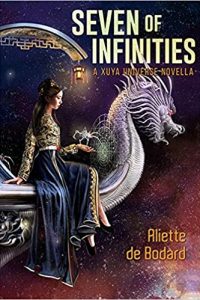Lila Garrott Reviews Time’s Convert by Deborah Harkness
 Time’s Convert, Deborah Harkness (Viking 978-0-399-56451-2, $29.00, 409pp, hc) September 2018.
Time’s Convert, Deborah Harkness (Viking 978-0-399-56451-2, $29.00, 409pp, hc) September 2018.
Time’s Convert is the fourth of Deborah Harkness’s All Souls series, and is the beginning of a new trilogy. It’s a cross between a supernatural romance, a domestic slice-of-life-with-magic, and an historical picaresque: a long, roomy, eclectic novel set on being almost all things to almost all readers. The world of the series contains four separate species of human-appearing hominids, namely regular humans, vampires, witches, and daemons, as well as interventionist deities, complicated familial relationships, peculiar vampire customs, adorable small children, dragons, griffins, sumptuous architecture, art, furniture, and occasional time travel. The mood ranges from tragic to dramatic to light-hearted, sometimes on the same page, and there are a plethora of characters with various motivations, difficulties, backstories, and abilities. The scope is epic, but the details are sketched in with gentle precision. The astonishing thing is how enjoyable, emotionally satisfying, and crammed full of elements the novel manages to be, while never containing more than exceedingly trace quantities of plot.
As a romance novel, the book is unusual in that the emotional aspects of the romance have been completely settled before the book ever begins. Phoebe Taylor, twenty-three years old and human, decides to become a vampire in order to marry her lover Marcus, who already is one. Her rebirth as a vampire, her courses of study in her new powers, and her fraught interactions with her family of origin (supportive, but worried) are overseen by Marcus’s family, the ancient and wealthy de Clermonts. Traditionalist vampires, the de Clermonts adhere to strict social codes, which mean that Phoebe and Marcus cannot see each other for ninety days after she switches species. One major thread follows Phoebe and her guardians in Paris, as she learns to hunt, follow etiquette, and assert her own personality without losing self-control.
Marcus, meanwhile, joins another family in the French countryside. His vampiric maker/father, Matthew, and Matthew’s witch wife, Diana, protagonist of the previous trilogy, are raising their twin toddlers at an ancestral estate. Another thread of the novel follows the precocious appearance of the twins’ vampiric and witch powers, and the question of whether the family should enchant them to prevent them from using their magic until they are older.
The final major thread is Marcus’s reflections on his previous history and his attempts to reconcile himself to past mistakes. This takes the form of flashbacks to the 1770s, when a young and human Marcus served in the American medical corps during the Revolutionary War, and moves forward through his history as a brash young vampire, picking up such historical greatest hits as the French Revolution and the yellow fever epidemic that almost depopulated Philadelphia. Marcus hobnobs with Benjamin Franklin, Thomas Paine, Marat (apparently secretly a daemon), and the Marquis de Lafayette, all the while fighting with his vampiric family and trying to come to terms with the actions he took to rid himself of the abusiveness of his human one.
There is no single antagonist, though various characters take on that role at various points. Family squabbles are eventually settled through time and discussion, and the only real obstacle to most characters’ goals is that neither the progression of history nor transmogrification into an immortal automatically solves anyone’s psychological issues. It’s always obvious that Phoebe and Marcus will reunite and marry, as they planned: the question is how well-prepared and healthy they will be when they do. Suspense, therefore, is not really a component of the novel, but would also be beside the point. This is a book about slow healing and slow growth, and its epic length and sprawling world are necessary to give the characters enough space for that healing and growth to proceed in a realistic way.
That said, things do occasionally become too convoluted. People who have not read the preceding trilogy may well not be able to figure out exactly how everyone is related to one another, or why a particular piece of vampire etiquette makes any sense. The book’s threads interweave well, mostly, but one gets the sense with the domestic raising-children side that Harkness was shoehorning in some reason for the previous protagonist to be relevant, and then continued to shovel in complications in hopes of keeping things moving. This was not necessary and feels contrived, especially since said protagonist turns out to be able to solve her problems basically by telling all the other adults to shut up, which she could conceivably have done at any point.
Also, though there are many wonderful female characters with agency, personality, and interesting backstories, the males who get the most focus tend to be, for various reasons, compelled to behave in very standard romance-novel ways – Matthew, for instance, has a disease called bloodrage, which makes him occasionally lose control, isolate himself, and brood about enough for a Brontë. This means that the men don’t feel as three-dimensional as the women, more wish-fulfillment than accurate portrait. Given the preponderance of books in which precisely the opposite is true, this may not actually qualify as a flaw.
It should be interesting to see where Harkness’s attention moves next in this trilogy, as she has her pick of possible situations, characters, and settings. Results, based on this book, promise to be entertaining.
This review and more like it in the September 2018 issue of Locus.
 While you are here, please take a moment to support Locus with a one-time or recurring donation. We rely on reader donations to keep the magazine and site going, and would like to keep the site paywall free, but WE NEED YOUR FINANCIAL SUPPORT to continue quality coverage of the science fiction and fantasy field.
While you are here, please take a moment to support Locus with a one-time or recurring donation. We rely on reader donations to keep the magazine and site going, and would like to keep the site paywall free, but WE NEED YOUR FINANCIAL SUPPORT to continue quality coverage of the science fiction and fantasy field.








